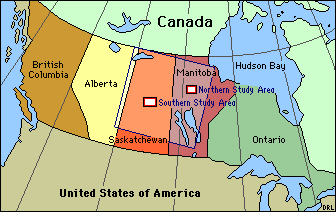
The BOREAS Project
The Boreal Ecosystem-Atmosphere Study (BOREAS) is a large-scale international interdisciplinary experiment in the northern boreal forests of Canada. Its goal is to improve our understanding of the boreal forests -- how they interact with the atmosphere, how much CO2 they can store, and how climate change will affect them. BOREAS wants to learn to use satellite data to monitor the forests, and to improve computer simulation and weather models so scientists can anticipate the effects of global change.
Where Was BOREAS Done?
The large-scale study area for BOREAS is a 1000 x 1000 km area covering most of Saskatchewan and Manitoba, Canada -- called the BOREAS Study Region. Within that region are two specific study areas -- the Northern Study Area (NSA) in Thompson Manitoba, and the Southern Study Area (SSA) in Prince Albert Saskatchewan.

Map of Canada showing the BOREAS Study Region and the Northern and Southern Sites.
Click on a site to visit that sites page (Netscape 2.0 or higher)
The BOREAS Science Groups
BOREAS has 85 science teams organized into six disciplinary groups (listed below). The 1994 and 1996 BOREAS field campaigns put over 300 scientists and aircrew into the field, supported by eleven research aircraft.
Read an Overview of the BOREAS Science Groups.
The BOREAS Field Campaigns
There were five field campaigns held in 1994 in Canada, lasting for a total of 123 days. We now have a surface-atmosphere energy flux data set supported by ecological, trace gas, hydrological and remote sensing science observations on the northern boreal forest. The energy fluxes were measured with a network of ten towers and four flux aircraft. Over 350 airborne missions (airborne flux and remote sensing) were flown during the 1994 field year.
Read an in-depth description of the BOREAS Field Campaigns.
The ground teams were active from the beginning of IFC-1 through IFC-3 and beyond in 1994. Most of the tower flux sites were operating during this entire period along with associated soil moisture, ecological, and trace gas studies.
Preliminary Findings for 1994
Preliminary analyses of the data indicate that the photosynthetic capacity of the boreal forest is much lower than the temperate forests to the south. This is shown by very low photosynthetic and carbon drawdown rates, associated with low transpiration rates (less than 2 mm of water per day over the growing season for the coniferous species). The strong sensible fluxes caused by this often lead to deep dry atmospheric boundary layers over the region, particularly during the spring and early summer -- making this area much drier than expected. This strong control of evapotranspiration in the biome is not well represented in most general circulation models of the atmosphere (global climate models).
Read a detailed list of Preliminary Results by Science Group (1994 data)
Read an overall Summary of BOREAS Results (1994 data)
See a List of BOREAS Papers Available
World-Wide Web Information
We recommend that you use Netscape Navigator to view these pages, not only for its advanced display capabilities, but also its ability to download the data from our FTP server. Read more about why Netscape is recommended.
 Download Netscape now
Download Netscape now
 See a list of other related Web pages
See a list of other related Web pages
 Check out what's new at the BOREAS WWW site
Check out what's new at the BOREAS WWW site
 E-Mail comments or problems on the BOREAS Web pages
E-Mail comments or problems on the BOREAS Web pages
 These Web pages are stored at NASA/Goddard Space Flight Center, Greenbelt, MD, USA
These Web pages are stored at NASA/Goddard Space Flight Center, Greenbelt, MD, USA
URL: http://boreas.gsfc.nasa.gov/
Creator: David R. Landis (landis@ltpmail.gsfc.nasa.gov)
Curator: David R. Landis (landis@ltpmail.gsfc.nasa.gov)
Cognizant NASA Scientist: Dr. Forrest G. Hall (fghall@ltpmail.gsfc.nasa.gov)
Last Updated: March 16, 1999




 See a list of other related Web pages
See a list of other related Web pages
 Check out what's new at the BOREAS WWW site
Check out what's new at the BOREAS WWW site
 E-Mail comments or problems on the BOREAS Web pages
E-Mail comments or problems on the BOREAS Web pages
 These Web pages are stored at NASA/Goddard Space Flight Center, Greenbelt, MD, USA
These Web pages are stored at NASA/Goddard Space Flight Center, Greenbelt, MD, USA
